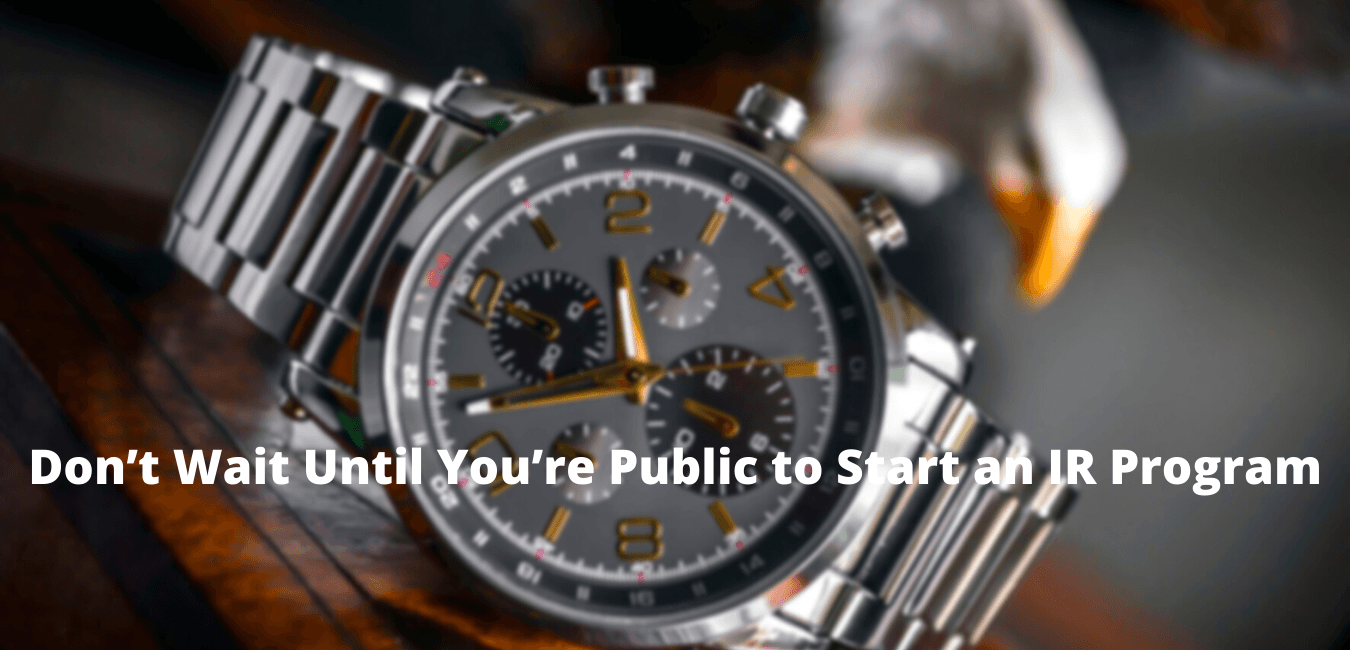By Stephen Kilmer
I was directly introduced to the wonderful world of IR in 1997 by accepting the position of Manager of Investor Relations with  Toronto, Ontario-based “LASIK” eye surgery pioneer, TLC Vision Corporation.
Toronto, Ontario-based “LASIK” eye surgery pioneer, TLC Vision Corporation.
The first years at TLC were marked by absolutely “hyper” business and stock price growth. The company had taken the U.S. market by storm and by 1999 our stock was trading at 10x sales and our trading ratio on NASDAQ vs. the TSX was easily 75/25. Then, without warning, a severe and protracted price war devastated the LASIK industry. While we eventually went on to “win” the industry price war, our stock was crushed beyond recognition and both the sell- and buy-sides had gone from loving it to hating it.
After a very long time dutifully spent “thinking,” “salvation” finally came in the form of a $6 million investment that ultimately gave TLC control of a Tampa, Florida-based private ophthalmic device company, Vascular Sciences Corp, which was in the process of developing a novel blood filtration procedure — RHEO — to treat the dry form of an eye condition called age-related macular degeneration (“Dry AMD”). The Florida company had a controversial past and retinal specialists were generally skeptical of both the company and its technology. The private managers, therefore, had great difficulty raising the capital needed to complete their clinical trials.
The “voodoo” quality of the RHEO procedure hadn’t, however, put TLC off one bit. After all, it wasn’t too many years prior that a large percentage of eye doctors had dismissed LASIK as complete heresy — and very quickly thereafter LASIK grew to be the world’s most widely-performed elective surgical procedure. In addition, everything we had seen in our clinical due diligence process, including an interim analysis of the pivotal trial data, led us to believe that the RHEO procedure was effective in treating Dry AMD. While we were convinced, external stakeholders largely ignored the important corporate developments.
Needed: The Investment Story
The investment story became very clear to me – quickly. Some 13 million people in the United States are afflicted with Dry AMD and about eight million of those could reasonably be expected to benefit from the RHEO procedure.
The procedure consists of eight treatments and each treatment required one disposable RHEO filter set that we planned on selling to service providers at $1,200.00 per. Therefore, every one percent penetration into the available market would generate $768 million in treatment set sales. Keeping in mind that this was a Medicare-eligible patient population, there was no competing treatment and, if left untreated, patients faced losing their vision and their independence. It followed that the investment thesis was compelling but extremely binary: if the full pivotal trial data was positive and the FDA approved the procedure, the market could be worth billions of dollars; if not, the market would be worthless.
As I tried to reach out to traditional money managers to tell the RHEO story, it felt very much like I was talking into the wind. Then it dawned on me — given their compensation structure and different approach to risk management, the then-emerging hedge fund community was much more likely to embrace the RHEO opportunity. I had just read an article on the NIRI Web site arguing that, contrary to popular belief, less than 5% of U.S. hedge funds had a short bias. Despite this important fact, many IRO’s, CFO’s and CEO’s were reportedly still reluctant to interact with them. I recognized that the added benefit of targeting hedge funds was that I wouldn’t be competing with very many other issuers trying to get the same audience’s attention.
Hedge Fund Strategy
My strategy was to start very slowly, building relationships with the managers of smaller hedge funds — with less than $50 million under management — and vetting the company’s story with them first. After some refinement, the story became ready for prime-time and I turned to this group of small hedge fund managers for personal introductions to the institutional sales desks and the respective personalities that they relied on most.
With the help of these sales desks, I organized and executed an “expert tour” with a very knowledgeable TLC optometrist from Oklahoma to discuss Dry AMD and the RHEO treatment with money managers We traveled to one or two major cities, usually once or twice a month, meeting with locally-based hedge fund managers. I also launched a hedge fund-dedicated “TLC World” e-news service to provide extra historical, industry and scientific perspective for the money managers; very quickly, I became the “go-to” person for hedge fund managers wanting to learn about anything that had to do with AMD.
Let’s Do an IPO!
After about ten months of this kind of marketing to U.S. hedge funds, TLC’s stock had risen more than 500%. One day, feeling absolutely Herculean, I walked into my CEO’s office and proclaimed that I could take our Vascular Sciences subsidiary public if he and TLC’s Board wanted me to. He agreed without too much hesitation, but made it conditional upon my personally taking the lead in managing the transaction all the way from underwriter recruitment/ selection, to prospectus drafting, to road show design and execution — with the noted exception of me having to give any public presentations on my own. I also continued to be TLC’s sole IRO throughout the process.
We decided to list the IPO on both NASDAQ and the TSX, the latter largely in order to accommodate TLC’s by-now minority Canadian shareholder base. Vascular Sciences had no real infrastructure of its own (no internal council and no permanent CFO) and didn’t have audited financial results. We were forced to run a rather cumbersome dual process where we — the issuer’s council, underwriter’s council, the lead bankers and I –worked on the front part of the book while our interim CFO worked with the external auditors to complete the financial section.
Enter the Speculators
About half way through drafting, conflicting speculation on TLC’s plans for Vascular Sciences emerged. On one side, a large and well-known hedge fund reportedly initiated a significant short position in TLC, theorizing that no attempt would be made to IPO the RHEO business and, even if there was, the IPO would fail. After establishing their position, they (according to reliable sources) paid or otherwise encouraged a small “independent” research shop to put out a series of very negative and inflammatory reports on both TLC and the RHEO procedure. In contrast, Canada’s national daily newspaper started to run unconfirmed stories that an IPO was imminent and that the analysts were expecting it to be a huge success.
The OccuLogix IPO in 2004
After an extraordinary amount of effort by all parties, we finally filed the S1 for the spin-out of Vascular Sciences – now renamed OccuLogix — in August 2004. Following SEC review of the document (OccuLogix was incorporated in Delaware), the drafting and filing of amendments, and more, our IPO road show was launched approximately 13 weeks later.
The tour brought us to 15 North American cities over 14 business days. Our original pricing range was $8-$10, but that was raised to $10-$12 about half way through marketing. We priced at $12 (33% above the original filing mid-point), raising $100 million at a post-money valuation of $525 million.
Lesson: Tailor the Audience to the Message
By tailoring our audience to our message instead of the other way around, and by embracing non-traditional investment managers instead of running away from them, we were able to pull off the “impossible.” OccuLogix was reportedly the first non-FDA approved/pre-revenue medical device company to successfully go public on a major U.S. exchange in over a decade. It was also the largest healthcare IPO in Canadian market history. Most impressively, TLC achieved $295 million in aggregate cash and paper gains — primarily from its retention of 53% of OccuLogix’ shares — through the OccuLogix IPO in return for its original $6 million investment.
End of story: I moved exclusively to OccuLogix from TLC following the IPO and, after many more twists and turns, recently left to co-found my own IR agency in Toronto.
While I feel equally comfortable operating on both sides of the northern border, I believe now that my true niche is in helping Canadian and other non-U.S. issuers successfully navigate and penetrate the U.S. capital markets. There were many hard-won lessons for me coming out of the IPO – and I hope that readers can benefit from some of the story as told here by a former corporate IRO.
Steve Kilmer is co-founder and Managing Partner of Kilmer-Lucas
email: stephen@kilmerlucas.com | Web site: www.kilmerlucas.com

Since 2005 ITB Solutions has provided listings development services to stock Exchanges in Canada such as the Canadian Securities Exchange. ITB Solutions currently provides New Listing Services to the NEO Exchange. We assist companies with the listing application and managing the process to become publicly tradable in Canada, as well as offering advice on how to make the most of your public listing. You can reach Jeffrey Stanger at 647-500-0492 or by email at jeffrey@itbsolutions.ca









